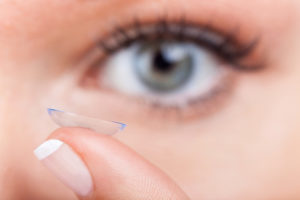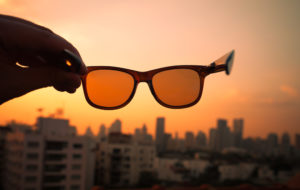Colorblindness: What it Means to be “Colorblind”
Having poor color vision is a problem that is more common than you would think. Most people refer to having poor color vision as suffering from “colorblindness,” however, there are different levels at which you can be “colorblind.” People who only see in black and white and experience true “colorblindness” are incredibly rare.
Colorblindness runs in the family unfortunately, so if you have a relative who is colorblind there is a strong chance that you or someone else in your family will be born with colorblindness. Studies have shown that people born with colorblindness are predominantly men. Studies also show that the most common form of colorblindness is the inability to distinguish red and green. On the less common side of the coin, there are people who are unable to distinguish shades of blue and yellow as well.
Aside from being born with colorblindness you can also develop it due to some eye diseases and medications—eye trauma could also potentially cause colorblindness in certain circumstances.
There is a chance that you have been colorblind your entire life and just not known about it. There are some people who only find out they are colorblind by chance—which can be potentially dangerous in the instance they cant tell the difference between a green and red light at a traffic stop.
Those who are affected by colorblindness may have difficulty seeing:
- Shades of red and green
- Shades of blue and yellow
- All color
If you think there is a chance you have issues with distinguishing certain colors then you should consider scheduling an eye exam so your doctor can give you colorblindness tests and be sure once and for all.
Currently there is no cure for colorblindness, however if your inability to perceive color is caused by an eye injury or some type of illness then it is possible that treatment could return your color perception.

More and more people are making the decision to make healthier food choices every day. Generally, the goal is to improve heart health and lose weight, which are both valid and great goals, but certain foods can also actually help your eye health and reduce your risks of developing certain eye diseases. Studies have shown that your risks of developing cataracts, macular degeneration and dry eye can be reduced if you make healthier food choices.
Here are a few different food groups that you should explore adding to your diet:
Orange Vegetables and Fruits
As I’m sure most people know, carrots are considered to be good for your eye health. This is because they have high levels of Beta Carotene in them—a precursor to Vitamin A and the reason for the orange color. If a fruit or vegetable is orange, chances are there is high levels of Beta Carotene involved. Beta Carotene helps to improve your vision at night and in dark environments. Look to add squash, carrots, apricots and/or pumpkin to your diet for a healthy boost to your eye health.
Dark Green Vegetables
If you haven’t already jumped on the kale band wagon, you might want to consider it. Dark green vegetables like kale, spinach, broccoli and collard greens all include two essential nutrients—lutein and xeaxanthin. Both of these important nutrients are known to help reduce damage to your cells and slow the effects of macular degeneration—a progressive vision loss eye disease that is seen in many senior citizens.
Fatty Fish
The omega-3 fatty acids that are commonly found in salmon, tuna and sardines have been known to help reduce your risks of developing eye inflammation and dryness—this in turn helps to reduce your risks of developing dry eye and macular degeneration. Adding some oily fish to your diet is not only good for your overall eye health, but also has health benefits for your heart.
Nuts
Vitamin E is considered to be a powerful antioxidant that can help if you have issues with heart disease and glaucoma. Glaucoma is a serious eye disease that can cause major vision loss if not monitored carefully. Certain studies have shown that vitamin E can also reduce the progression of vision loss from cataracts. Nuts are a great source of Vitamin E, but be careful you aren’t over eating them because they are high in sodium and calories.
For more information on how you can build your diet around improving your eye health, consult your eye doctor and they can help you review your options.

Chance are, if you are one of 35+ million contact lens users in America, you were taught all the basics of proper contact lens hygiene when you first received your prescription. There are probably even better odds that you currently aren’t following those contact lens hygiene basics you were taught every single day.
Millions of contact lens users deal with eye complications every year because they wear their contacts in the pool, don’t take them out when they sleep or just don’t take them out ever. It is easy to assume that you’ll be fine, but this really isn’t the case.
Here are three non-hygienic things that you most likely have done at some point as a contact lens user:
Let tap water come in contact with your contacts
This can pose a serious issue for your eyes health, the reason is tap water is not salty like your eyes natural tears, so your contact lenses end up absorbing more of it and swelling. You might be thinking “Well, what does that matter?” It matters because tap water—while safe enough to drink—isn’t sterile and therefore can contain a lot of microorganisms. This creates a double whammy effect because as your lens swells it pulls on your cornea and can cause microscopic openings that allow those microorganisms to get into your eye and cause possible infection. This is why you should absolutely NOT shower or swim with your contact lenses in.
Don’t have contact lens solution, so you use your own saliva in emergency situations
Well, if you thought exposing your contact lenses to tap water was bad, you are in for a real treat with this one. The saliva in your mouth is absolutely ridden with bacteria that can be quite damaging in any place outside of your mouth. You might be better off rubbing your contact lenses into a petri dish at a science lab—which is an absolutely terrible idea.
If your contact lenses are bothering and there isn’t contact lens solution readily available, then you should just take them out of your eyes. If you want to prepare for these emergencies, then you should have a small travel bottle of contact lens solution on your person at all times.
Trying to cut corners on costs, so you re-use contact lens solution.
The purpose of contact lens solution is to clean bacteria and debris off of your contact lenses. These bacteria and debris don’t go away, so if you choose to re-use that dirty contact lens solution you are essentially marinating your contact lenses in filth.
Here is an analogy for you, as your car runs the oil gets dirtier and dirtier and dirtier until you need to do an oil change. Re-using contact lens solution is like taking that old dirty oil you just took out of your car and deciding to put it back into the car with some new oil mixed in.

Sunglasses have been synonymous with the idea of “cool” for a long time and it isn’t hard to imagine why. It is hard to picture sunglasses without thinking about Tom Cruise rocking aviators while riding on a motorcycle. Sunglasses have been an important fashion accessory in our society for a long time now, but it is important to make sure your sunglasses aren’t just form and have some function as well.
Picking the right pair of shades can help to reduce wrinkles on your face from increase sun exposure as well as protect your eyes and prevent them from getting red and dry. The sun’s ultraviolet (UV) rays can cause permanent damage to your eye health if not blocked by UV protective eyewear.
Yes, you read that correctly, UV eye protection is important when picking out those slick looking shades. As mentioned above, the suns UV radiation can cause irreparable damage to your eyelids, cornea, lens and many other areas related to your eye. There is also plenty to data to show that excessive UV radiation exposure to your eyes can increase your risks of developing cataracts, pterygium and macular degeneration.
You might be asking yourself, “how do I know if the sunglasses I want block those UV rays?” Well Here is a little buyers guide to help you pick out sunglasses that no only look good, but also protect your vision:
- Make sure they are listed to block 99 – 100 percent of both UVA and UVB rays
- Screen 75 to 90 percent of visible light
- Ensure that the lenses are free from distortions and imperfections before you buy them
- For the most accurate color recognition possible, we recommend picking gray tone lenses
Despite popular believe, the level of darkness your lenses provide have nothing to do with how much UV rays are blocked. It is also recommended that you consider choosing wraparound and/or close-fitting sunglasses to give your eyes the maximum amount of UV ray protective coverage.

Well it is officially Spring, a time of beauty where plants spring into life and also a time of season allergies. Ocular allergies, commonly referred to as “eye allergies” are one of these Spring frustrations that millions of people deal with every year. If you suffer from Spring allergies, then you might end up having to deal with watery and/or irritated red eyes.
So What Causes Spring Allergies?
Well, a lot of things, but in the spring there are two types of allergies that you need to look out for:
- Seasonal Allergies: These are the common allergies that your eyes become subjected to and definitely very big in the Spring. These are caused by allergies to pollen from bloom plant life such as weeds, grass and trees.
- Perennial Allergies: These last throughout the year and are usually caused by allergies to dust and different animals. Smoke can also trigger an allergic response as well as colognes and pollution.
There are plenty of times when you can easily identify the cause of your allergic reactions, but seeing a doctor might be necessary to determine what is triggering your allergic reactions. Once you figure out what it is that is bothering you, there are things that can be done to help reduce your exposure to those allergens.
Here are some useful tips on how you can limit your exposure to allergens:
- If the pollen counts are high, stay inside!
- If you are a contacts user, then you should consider removing them when you go outdoors because they can accumulate airborne allergens like pollen. Sunglasses can help to protect your eyes from these airborne risks.
- Your bed and pillow cases can actually get pretty dusty, so it is a good idea to regularly wash your sheets and pillowcases to limit your exposure to dust mites.
- Cleaning the floor with a damp mop helps to keep allergens from getting airborne when you are doing Spring cleaning.
- DO NOT rub your eyes! This only makes your allergic symptoms worse.
If your allergies are severe then it might be best for you to see a specialist. Reach out to your eye doctor regarding eye allergies if the conventional methods of fighting your allergies are producing the results you expected.
In an increasingly digital world issues such as digital eye strain are becoming more prevalent than ever before. The use of digital devices has become so ingrained in our day-to-day lives that we would have trouble surviving without them both professionally and personally. Every year that goes by we become even more dependent on these devices, so digital eye strain can only grow as an issue.
We rarely think about the impact this exposure to digital devices might be having on our vision and because of that we deal with recurring headaches, blurred vision and other symptoms of digital eye strain.
So with all this in mind, here are 5 tips to help protect your vision in a digital world:
- Lighting matters: As they say in the photography world “lighting, lighting, lighting!” Lighting doesn’t just matter in a photo shoot, lighting matters in your every day lives as well. If you work in an office and spend a large amount of time staring at a screen it is important to adjust your monitor settings so as to not strain your eyes. The lights above your head make a huge difference as well, if they are producing too much light then your eyes will become fatigued from over-exposure, on the other side if the lights are too dim, then your eyes will get strained over time. It is recommended that you keep your source of light off to the side of you, rather than at your front or back.
- Adapt your environment to your needs: It is a good idea to customize your environment to what is most comfortable for you. Using a large monitor or a screen magnifier for your computer helps to reduce symptoms of eye strain. Don’t sit too far back from your computer either, because that can cause your eyes to get strained. Believe it or not having a comfortable chair can do a lot for your eyes, because it reduces the amount of stress you put on your eyes when you are constantly adjusting how you are sitting for the best angle of view.
- Read at the right angle: This is pretty specific, but it has been known to help. It is important to ensure that your computer monitor is positioned slightly below your eye level, so that you are looking slightly downward at it. Sitting approximately 24 – 28 inches away from your screen is recommended as well.
- Don’t forget to blink: Statistics show that people blink a lot less when they are using digital devices, which causes your eyes to get strained over time. It is a good idea to remind yourself to give your eyes a break after once in a while in the office. You would be surprised at how much of a difference it makes when you take a moment to close your eyes for a few seconds every 20 minutes.
- Magnify your text: If you already have vision complications then settings your text to be magnified for easier reading helps to reduce symptoms of eye strain. Just about every type of digital device has options to increase the size of the text on your screen to make it easier to read so you don’t have to squint so much.

I’m sure at some point you’ve felt the nagging discomfort of having a stye on your eyelid. Styes are similar to a pimple, but they form on your upper or lower eyelid. The stye inflammation of the eyelid can be caused by a couple things—either an oil duct is blocked up on your eyelid, or germs such as a staphylococcal bacterium have been trapped with dead skin cells on the eyelid. Usually, styes are never more than a superficial frustration, but they can form deeper in the eyelid.
There are two types of styes that you can develop:
- External Stye: Starts like a pimple next to your eyelashes, but then turns red and begins to cause discomfort. Generally, these last several days before eventually bursting and healing. Most of the time external styes come, go and heal all on their own, but in rare circumstances you may require the care of an eye doctor.
- Internal Stye: These styes grow on the underside of your eyelid and become red and inflamed much like the external stye, but internal styes tend to be more serious because their location prevents a whitehead from forming thus sealing in the infection. Internal styes may disappear completely without medical intervention, but it can also leave a fluid-filled cyst that may need to be opened by an eye doctor and drained.
Should the stye never heal, you will develop scar tissue that forms a permanent painless bump on your eyelid. These bumps are called chronic chalazion and like styes, are generally harmless and rarely affect your eye or vision. There are rare cases in which it can lead to an infection in your face called cellulitis which can be very serious. If you feel that your stye or chalazion are becoming a more serious problem, then it is important that you see an eye doctor and undergo a proper examination.

Color vision deficiency or, as it is more commonly known, color blindness, occurs when you are unable to perceive a wide spectrum of colors that the eye should be able to see. Color blindness can affect people at a variety of different levels, some may just only be unable to discern shades of red and green while others might see the world only in shades of grey. The most common color blindness affliction is the inability to discern shades of red and green, but a small percentage of people who suffer from color blindness will only see the world in black and white.
In most cases color blindness is inherited and passed down through the generations, but there are some instances where color blindness can be caused by injury or disease or other possible circumstances. Unfortunately, those who inherited their color blindness from a relative will most likely have to deal with the symptoms of color blindness their entire life.
If the optic nerve or retina is damaged in some way, it could cause you to develop some level of color blindness. Diseases such as diabetes, glaucoma, Alzheimer’s disease, Parkinson’s disease, age-related macular degeneration and multiple sclerosis have been known to cause symptoms of color blindness. If you have injured your eye or have one of the aforementioned diseases, it is important that you consult your eye doctor about your vision to ensure everything is working properly.
Some prescription medications have been known in rare cases to cause symptoms of color blindness as well. Medications used to treat heart disease, high blood pressure, depression and other psychological problems have been known to occasionally cause issues with color blindness.
Genetically speaking those who are at the highest risk of developing color blindness are white males. In fact, 8 percent of all white males will struggle with color deficiency at some point in their lifetime, while only 0.5 percent of women will have to deal with color blindness.
If you believe you are having difficulty discerning different tints and shades of color, then it is recommending that you call your eye doctor and set up a regular comprehensive eye exam.

Digital eye strain is a rapidly growing issue in today’s computer reliant world. If you work in an office, chances are you will be spending quite some time in front of a computer screen which can cause your eyes to strain. In fact, 70 percent of Americans who work with computers on a daily basis deal with symptoms of digital eye strain. Luckily, there are some precautions you can take to help prevent digital eye strain and protect your vision.
To further promote eye health and safety in the workplace, here are 3 ways you can protect your vision from digital eye strain:
- Don’t forget to blink: This may seem like a no brainer, but studies have shown that when we use computers we tend to blink a lot less, which causes your eyes to become dry and irritated. Blinking helps to keep your eyes lubricated and also helps to spread necessary nutrients across the eye.
- Using proper levels of Lighting: One of the biggest causes of digital eye straight is poor lighting and glare on computer screens. If the overhead lights are too bright then you should position your computer screen in a way that doesn’t reflect the lights and create glare. Light coming in through the windows can be difficult as well, depending on the time of day, so you might want to consider closing the blinds if necessary.
- Step away from your computer occasionally: There is a technique that can help you avoid digital eye strain called the 20/20/20 rule. This is an easy enough system to work into your daily routine. You just need to look away from your computer every 20 minutes at an object that is at least 20 feet away for 20 seconds or more. This technique is said to reset your eyes and keep them from getting strained.
Taking these necessary steps to help avoid digital eye strain is not only great for you, but also your productivity in the workplace, so why not give it a try? If your eyes continue to be strained, then it is recommended that you see an eye doctor for a routine eye exam.

Having routine eye exams is important for more reasons than to just make sure your eye prescription is up to date. Only eye doctors are equipped with the knowledge to detect vision problems early. If you find you are suffering from recurring headaches, then there might be something wrong with your vision. While not all headaches are caused by a problem with your vision, they have been known to be a common cause. It is important to have routine eye exams to ensure your eyes are in tip top shape.
The reason eye problems and headaches tend to be associated with one another is because of eyestrain—when the small muscles in your eye are forced to work harder than they should. Aside from the headaches, this causes your eyes to become tired and ache, as well as blur your vision. There are a number of things that can cause these eyestrain related headaches.
Here are a few things that might be the reason you are having recurring headaches:
- Hyperopia: More commonly known as farsightedness, hyperopia is when your eye has difficulty focusing on things that are up close. The light that enters your eye does not focus correctly on your retina, and instead it focuses behind it.
- Presbyopia: Presbyopia occurs when the lens of your eye begins to lose its elasticity, this has been known to occur in middle and senior aged people. As the lens becomes less flexible it loses its ability to properly focus light and your eyes start to feel sore.
- Astigmatism: An astigmatism occurs when the cornea of your eye is unnaturally shaped. In most cases this means the cornea is oblong shaped instead of being circular. If you have an astigmatism, you will find yourself squinting often, which strains your eyes.
Save yourself the discomfort and make sure to schedule regular eye exams with an eye doctor to ensure your vision is being taken care of.
